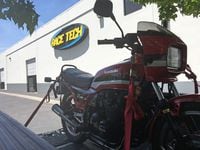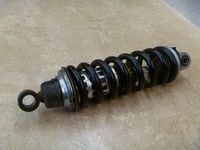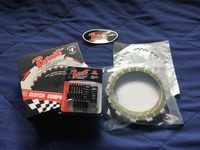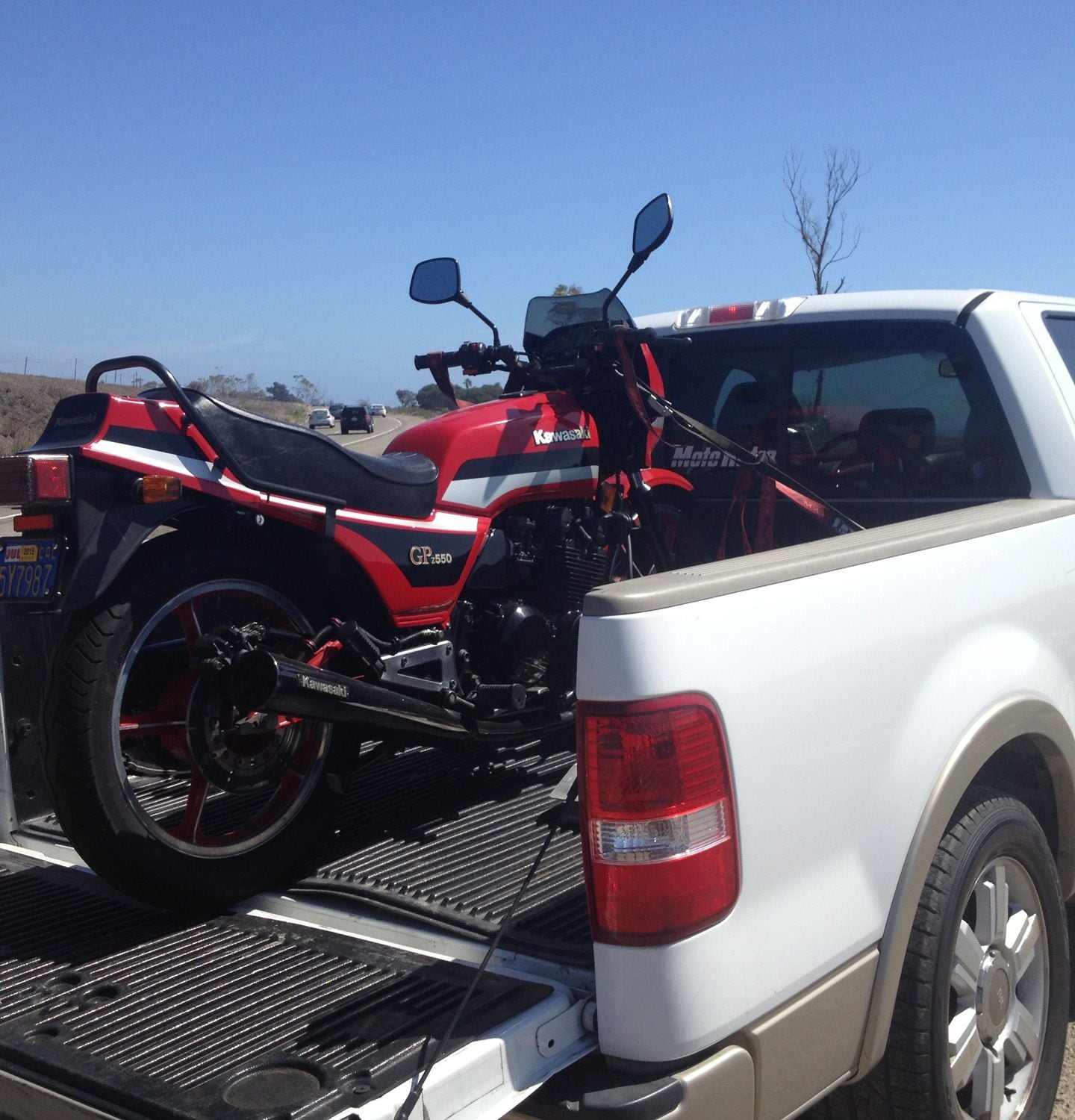A couple months ago in this very space I recounted the sad tale of my recent Kawasaki GPz550 purchase (click here to see The GPz Files: Part 1). Basically, I found a completely stock and beautiful-looking 1983 Kawasaki GPz550 up in Sacramento eight or 10 months ago, and having owned one of those very cool monoshockers back in college, and being highly—and expensively—susceptible to flights of emotional back-in-the-day fancy, I just had to buy the thing. Of course, as usual, I trusted the owner too much—and thusly paid more than I should have.
Had the bike been as solid mechanically as it was aesthetically, I’d have been golden. But it had gummed carbs, completely worn-out suspension, a bad petcock, a weak clutch, and worst of all a bad base-gasket leak, which the previous owner said was minor. The carbs and base-gasket fixes cost me a cool $1,500 on top of the $3,000 I paid for the bike, but once they were done—and done well by Century Motorcycles in San Pedro, CA—the thing ran great.
Of course, the suspension then became a huge problem. And so, with the sound of the fork clanking away fresh in my ears, I trucked the GPz to Race Tech (www.racetech.com) for some freshening. I've known Race Tech founder Paul Thede for a long time, and he set his capable guys on it right away. And when I got an email saying it was ready 10 days later, and I headed east to Corona to see what they'd done.
They'd done quite a lot, actually, but not quite as much as I'd imagined. I'll explain. In Part 1, I wrote that because the rear shock wasn't a rebuildable unit, the RT guys would have to build a completely new—and very expensive—shock for the bike. Silly me. Turns out these old "non-rebuildable" emulsion shocks actually are rebuildable once they're modified with a special valve.
“Basically,” Race Tech suspension guru Tyler Southerlin told me when I picked up the bike, “we drill, tap and fit the shock body with a 5mm nitrogen valve. This allows us to drain the old nitrogen and add fresh stuff once the oil and seals have been replaced. It basically turns a non-rebuildable shock into a rebuildable one.”
Which is exactly what Southerlin did to my GPz’s stock damper. He then topped it off with an appropriately red 9.8 kg/mm spring in place of the 7.8 kg/mm spring that came on the bike stock. That’s basically two steps up on spring rate from stock, which seemed about right, as I’m quite a bit heavier than the 155-pound guy Kawasaki engineers had in mind when they set the GPz’s suspension values way back in the early 1980s. Of course, with the stiffer spring, compression and rebound values were upped a bit as well.
A custom-built, new-generation shock, one with modern valving, separate rebound and compression clickers, and a remote reservoir, would have been better functionally, and would obviously have offered more adjustability (and probably better durability over time). But that’s a much more expensive way to go ($1,000 and up), and this minimum fix—which, at about $500, folks can more easily afford—seemed a good alternative, at least at this point.
Up front, the GPz’s skinny, 35mm fork tubes got the standard Race Tech treatment: Firmer springs (.80 kg/mm units in place of the flaccid .60s), fresh 20-weight oil, fresh seals, and Race Tech’s Cartridge Emulators, which basically turn a non-cartridge damper-rod fork into one that thinks it’s a more advanced cartridge unit. The key to the Emulator valve is its ability to separate the compression and rebound circuits more effectively.
When I arrived at Race Tech and rolled the bike off its centerstand, I immediately knew we were in the ballpark spring rate-wise. The bike just felt right, with a nicely balanced feel when pushing down at the bike’s weight midpoint (roughly the back of the fuel tank), with both wheels moving up and down in sync and at about the same amount for a given push. If either the fork springs or shock spring was too firm or too soft relative to the other end, you’d notice a difference. I didn't.
Of course, with this so-far cursed machine, something’s always wrong, and this time was no different. On my short test ride near the Race Tech facility before tossing the bike into my pickup, I noticed the clutch was slipping. Ugh. The GPz felt really good suspension wise in my quick, 2-mile ride, but it’d need some clutch TLC before I could really find out for sure.
A call to Barnett (www.barnettclutches.com) got me a clutch kit featuring Kevlar friction plates, steel plates and springs (part #302-45-10013, retail $103), which was installed by my now-really-good-friends at Century Motorcycles a few days later. Once I got the thing back out on the road I had no clutch problems whatsoever; just smooth engagement, no slippage, and no additional grip strength needed (vs. stock) at the lever. Nice.
With the engine running smoothly and the clutch fixed, I was finally able to shake the GPz out a little. And the suspension action that had felt so good at Race Tech proved near-perfect on the road, feeling supple yet controlled on the rougher, pock-marked pavement of my local towns, and fully composed on the faster, sweeping roads I tried over the weekend. I needed to bump spring preload in back a little so the sag settings were in the ballpark, but once I did it all worked wonderfully, with excellent chassis balance and great wheel control and bump absorption. Offering supple ride quality and wheel control when speeds are elevated is not an easy thing to manage, especially on a 33 year-old motorcycle. But Race Tech managed to do just that on my GPz, and that's the primary reason I continue to see them for my suspension needs, dirt or street.
I should give a shout out to the nearly new Bridgestone BT45 tires (100/90-19 F and 120/90-18 R) that came on the bike. They offer excellent grip and have a wonderfully round profile, which results in seriously neutral steering feel and roll-in characteristics when entering corners. I’m really impressed with the BT45s, and would happily put them on any of my retro-oriented streetbikes.
So… It’s been an exciting, frustrating, expensive and—finally!—satisfying year with my cursed-but-loved GPz550. What I have now, after the oil leaks and carb problems and suspension flaccidity (it that isn’t a word, it should be!), is the bike I envisioned when I handed over the check many moons ago. I’m now into the thing about five big ones. But when I see its shiny paint and glossy black bits in the afternoon light, and hear the thing rev semi-menacingly when I blip the throttle (it’s still got its stock exhaust, after all), it’s 1983 all over again, I’m in college, and a run up Little Cottonwood canyon is just minutes away. And that feeing is worth every penny.
Now, back to my Suzuki GS1000S project, which Race Tech and Southerlin also have a hand in, though not in the way you might expect…











/cloudfront-us-east-1.images.arcpublishing.com/octane/BO5NCYOGI6NORAX7PAMIVAADWM.jpg)






/cloudfront-us-east-1.images.arcpublishing.com/octane/S35YGSEMEZB4BLTDJTSZPF4GLA.jpg)
/cloudfront-us-east-1.images.arcpublishing.com/octane/5UOT6HPX2JFMRJAX6EH45AR4MQ.jpg)
/cloudfront-us-east-1.images.arcpublishing.com/octane/OKWOJWAKP5EP3OACCRRWPCIX2Q.jpg)
/cloudfront-us-east-1.images.arcpublishing.com/octane/2WF3SCE3NFBQXLDNJM7KMXA45E.jpg)
/cloudfront-us-east-1.images.arcpublishing.com/octane/G4MG6OUCJNBSHIS2MVVOTPX65E.jpg)
/cloudfront-us-east-1.images.arcpublishing.com/octane/IIGGWFOTOJGB7DB6DGBXCCMTDY.jpg)
/cloudfront-us-east-1.images.arcpublishing.com/octane/QSTCM6AVEZA5JJBUXNIQ3DSOF4.jpg)
/cloudfront-us-east-1.images.arcpublishing.com/octane/U4I7G625B5DMLF2DVIJDFZVV6M.jpg)
/cloudfront-us-east-1.images.arcpublishing.com/octane/B6XD6LS6IVCQPIU6HXDJSM3FHY.jpg)
/cloudfront-us-east-1.images.arcpublishing.com/octane/ICL63FEDDRDTTMINYICCEYGMDA.jpg)
/cloudfront-us-east-1.images.arcpublishing.com/octane/FCGZHQXRBZFLBAPC5SDIQLVF4I.jpg)
/cloudfront-us-east-1.images.arcpublishing.com/octane/WNOB6LDOIFFHJKPSVIWDYUGOPM.jpg)

/cloudfront-us-east-1.images.arcpublishing.com/octane/X33NU3E525ECRHXLNUJN2FTRKI.jpg)
/cloudfront-us-east-1.images.arcpublishing.com/octane/6KKT5NNL2JAVBOXMZYS5ZO76YA.jpg)
/cloudfront-us-east-1.images.arcpublishing.com/octane/J5RKG5O455GMPGQRF2OG6LRT7A.jpg)
/cloudfront-us-east-1.images.arcpublishing.com/octane/GX2CIZKQVRH2TATDM26KFG2DAE.jpg)
/cloudfront-us-east-1.images.arcpublishing.com/octane/ZWIDYSAKQZHD5BHREMQILXJCGM.jpg)
/cloudfront-us-east-1.images.arcpublishing.com/octane/CYUHJZCTSJCH3MRAQEIKXK7SCQ.jpg)
/cloudfront-us-east-1.images.arcpublishing.com/octane/LKOFINY56FCXJCANJ5M7ZDQUBY.jpg)
/cloudfront-us-east-1.images.arcpublishing.com/octane/4NBPDACMWJH63JQYJVK3QRBDZI.jpg)
/cloudfront-us-east-1.images.arcpublishing.com/octane/KKHQHRR3FJGX7H2IPU6RALMWG4.jpg)

/cloudfront-us-east-1.images.arcpublishing.com/octane/5IOFS5JAE5FOXMNA23ZRAVVYUU.jpg)